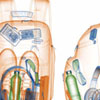
Xray May Alert Officials Before Tragedy Strikes
School violence is escalating but preventable
- By Mary Madaris
- Jul 01, 2012
After the tragedies at Columbine High School
and Virginia Tech, a growing emphasis on education security has emerged as schools face the
reality of this terrorist threat on the homefront.
In the 1999 Columbine shooting, high
school students Dylan Klebold and Eric Harris
brought firearms, knives and explosives on campus,
injuring 21 and killing 15, including themselves.
More startling, they also planted a cafeteria
explosive; had it detonated, it would have
killed an estimated 500 students.
More recently, in 2007, Seung-Hui Cho of Virginia Polytechnic
Institute and State University entered school buildings carrying two
handguns, wounding 17 and killing 32 before committing suicide.
Known as the “Virginia Tech Massacre,” this incident marks the deadliest
shooting by a single gunman in U.S. history.
Today, the threat of violence is not shrinking. In the 2005-2006
school year, 38 percent of public schools reported at least one incident
of violence. In the 2009-2010 school year, roughly 74 percent of public
schools reported such incidents of violence. In 2012 alone, three students
were killed in a Feb. 27 shooting at Chardon High School in
Chardon, Ohio, and seven students and staff were killed in an April 2
shooting at Oikos University in Oakland, Calif.
As the threat of violence escalates in U.S. schools, the problem
of school violence has become undeniable. The next question is if it’s
preventable.
The answer is yes. Checkpoint security at school entry points
offers a highly effective preventative measure that enables not only
the detection of firearms, but also knives, explosives, illegal drugs
and other contraband.
Walkthrough metal detectors check for hidden body weapons while X-ray inspection systems scan incoming backpacks, laptop bags,
purses and personal belongings to ensure schools have control
over what enters campus. On a given day, one in four Americans
are within a school building, an estimated 77 million. A growing
number of schools are realizing it is simply not worth the risk to go
without X-ray security measures.
Astrophysics Inc., an X-ray provider for numerous public
schools, is experienced in school security. Headquartered with a
factory just 25 miles east of Los Angeles. Astrophysics manufactures
all systems in the U.S.A. for the best in quality, reliability
and performance.
Schools typically install the XIS-5335S and XIS-6040M because
they are compact and require limited operational space while also
providing large enough tunnel sizes to effectively scan. The XIS-
5335S is the smallest system available and fits in confined spaces,
while the XIS-6040M is highly mobile, featuring pneumatic
wheels and stainless steel handle bars for maneuverability through
doors and hallways for fast relocation. Both the XIS-5335S and
XIS-6040M are cost-effective, high-value systems that ensure the
safety of our schools.
In 2009, a higher percentage of students ages 12-18 reported
that they were more afraid of attack or harm at school than away
from school. Providing an X-ray system can change a student’s
perception of school safety and foster academic success. Students
must feel safe within the necessary academic foundation for a good
education and a better future—a safe learning environment.
Students are not the only ones who recognize school safety is a
priority. In 2005, researchers at Xavier University of Louisiana surveyed
principals from more than 1,500 districts.
One principal in the study commented, “This school is wide
open to acts of terrorism. We have an open campus where almost
every room can be accessed for periods of time throughout the day.
“If it were the intention of any person to cause harm or damage
to persons or property, he or she would have a clear advantage.”
The Xavier study results revealed 64 percent of urban, 54 percent
of suburban and 43 percent of rural-area principals reported
violence had increased in their schools in the past 5 years. In fact,
each month approximately 40,000 students and 8,000 teachers are
physically attacked. Violence has transcended location.
Beyond the threat of violence, students also are at risk from exposure
to drugs. In 2009, about 25 percent of students reported drugs
were offered, sold or given to them at school. In addition to detecting
firearms and explosives, X-ray systems can detect narcotics.
Investing in an X-ray system not only secures students from the
threat of violence but also from the existence of drugs on campus.
Astrophysics offers an exclusive feature in its Screener Assist,
which is a programmable detection tool that enables operators
to target specific threats. Operators simply input the pre-set
atomic range of the threat object and Astrophysics software will
automatically analyze each screened image and insert a red
ellipse around that object. Up to four atomic range targets may
be programmed. Screener Assist is a powerful tool that enables
operators to automatically detect threats so screening is quick
and effective.
Ultimately, the way we think about school safety must change. If
parents, communities, school boards and administrators fail to
acknowledge the threat of violence in our schools and do not fund
the necessary preventative measures to secure our schools, we are
promoting violence and hindering our students’ potential. Education
starts with school, and school should start with safety.
This article originally appeared in the Security Products Magazine - July 2012 issue of Security Today.